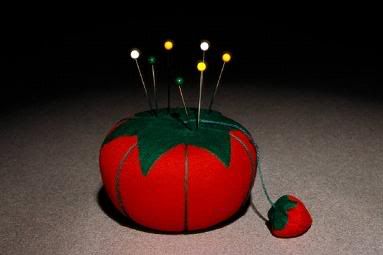Other posts in this series: All about Patterns, All about Fabrics, How to Dye Silk for Fabric Skating Skirts, Altering Your Growing Skater's Figure Skating Dress, Laying out the Pattern.
Laying out and cutting the pattern will take you longer than any other step. However, if your layout and cutting are terrible, the dress isn’t going to look right. Resign yourself to taking a long time with this process.
Before beginning this step, you should have prepared your pattern. If you haven’t, please read Ice Mom’s Sewing Guide: All about Patterns.
My set-up: I have a folding cut-out table on casters in my front room. I push the coffee table out of the center of the room, settle my dog and his dog bed by the door, wheel my cutting table in front of the wide-screen TV, and pop a DVD in the player (my preference: Dexter. Serial killing goes well with pinning and cutting.) I have two high wooden stools and I place them on either side of the table. A glass of iced tea and I’m set for two hours.
I know a very good seamstress who lays out and cuts patterns on her vinyl floor. That sounds uncomfortable to me. I used my kitchen table for years (rectangle are much better than round). I really like my white folding cut-out table, though, because it’s countertop height and it folds up so I can hide it behind the sofa. No stooping over the table to cut or pin. The table set me back $50; normally, it’s $100, but I had a half-price coupon at the fabric store.
You will need:
- Fabric, pre-washed (if washable)
- Pattern pieces (that you’ve traced and fitted)
- Sharp pins (dull ones snag, especially on Lycra)
- A long, wide table that you don’t mind nicked up
- Sharp fabric shears
- Sharp fabric snips
- Tailor’s chalk or disappearing ink fabric pen
- Iron and ironing board
- Flexible measuring tape
If you’re ironing velvet or anything with a pile (like panné, Polartec brand polar fleece, or velour), iron on the back side of the fabric, again to avoid that unattractive Iron Shroud of Turin effect.
It’s a fantastic idea to fold your fabric precisely in half as you iron, selvage edge to selvage edge. You want a line down the middle for the next step.
Put the fabric on the table. This might seem deadly obvious, but it’s not. Often pattern instructions don’t tell you how to orient the fabric on the table so you’ll be able to cut out all of the fabric pieces and not need more fabric.
For figure skating outfits, lay the fabric on the table, wrong side up with the ironed crease running down the table’s center and the selvage edges hanging over the sides. Bring the selvage edges up to the folded center so that the two selvage edges are touching. When you look at the fabric, you should see this: long fold, selvage edge at the center, opposite selvage edge at the center, long fold. At either end are two layers of cut edges.
You’re orienting the fabric in this manner so that you have more folds to work with. You also want to keep the fabric straight. You’ll orient your fabric parallel to the selvage edges, so you want to make sure that the fabric underneath is not crooked. Crooked fabric doesn’t lie well on the body.
Deal out the fabric pieces. Place the ironed pattern pieces on the fabric. If you see a straight line with two arrows on a pattern piece, that means that you’ll need to lay that piece out parallel to the selvage edges. If you see a line and arrows pointing to the cut edge of the fabric, that means to lay it out with the edge on the fold. Double-check what your pattern pieces are telling you, too. They’ll tell you if you need to cut on the fold or not. They’ll also tell you if you need one or two of the pieces.
I always orient my pattern pieces in the same direction. In other words, the tops of all the pattern pieces point the same way. This is a wise idea for fabrics with a pile or nap, like velvet. You know how velvet looks different from one direction to another? Yep. That’s why I lay all pattern pieces in the same direction, even if the fabric doesn’t have a nap.
It’s perfectly fine to turn a pattern piece wrong side up. That won’t affect anything.
Once you have all of your pieces in place on the fabric and you’re sure that you can cut them out without buying more fabric, you’re ready to pin.
Pin the fold lines and the grain lines first. I always start with pinning the fold lines first so the fabric doesn't shift around. I pin the pattern to the fabric parallel to the fold line and make sure that the fold line of the pattern matches the foldline of the fabric exactly.
For those of you who have never pinned before, there’s a trick to it. Begin stabbing the pattern and fabric at a 45-degree angle. When you hit the table, bring the pin back up at a 135-degree angle (the other 45-degree angle). If you’ve never pinned before, this will seem to take ages. Don’t worry – you’ll get better at it.
Next, pin down the grain lines. The grain line is the straight line with a error at both ends. Make sure this line is parallel to the selvages. Pin one end of the grain line to the fabric, keeping the pattern straight. With your measuring tape, measure the distance from the pinned part of the line to the selvage edge. Slide the tape measure down the line. Adjust the pattern piece so that the grain line end is at the same measurement as the first grain line end. Pin in place.
Smooth out and pin. Working parallel from your fold line or grain line pins, smooth out the pattern gently over the fabric and pin in place, parallel to the pattern edge about ¼ - ½ inch from the edge. You’re just smoothing things out here, you’re not stretching anything. Pin the entire pattern in place, making sure that the corners are tacked down.
That’s it for the layout post. Next post, we’ll cut!
Update: From reader Beth: When sewing on woven (non-stretchy) fabrics, the grainline (arrow on pattern pieces) should be parallel to the selvages. On stretchy fabrics the arrow follows the greatest degree of stretch in the fabric. Depending on the fabric, the grainline will be either parallel to or perpendicular to the selvage. On the disappearing ink or water soluble pens, always test on a scrap of fabric and never iron over those marks or they may become permanent. Don't ask how I know this.
Note from Ice Mom: Ugh. Don't ask how I know it, either.
Update: From reader Silver Blades who cautions sewers against letting excess fabric hang off the cutting table: I also forgot to mention two things about cutting out stretch fabrics. Do NOT let the fabric dangle over the edge of the cutting surface! It will stretch prior to cutting and once you cut the piece it will spring back and be too small. Yes, I have done this. I now pull up a chair or stool to the edge of the table or neatly fold the excess up at the table edge so it is not pulling itself out of shape.
Do you have any questions about this process? Better yet, did I leave something out? Even better: do you have a fabulous tip? Please write about it in the comments!
Have a question for Ice Mom and the Advisory Board? Do you have an idea for a post? Would you like to write a guest post? That's fabulous! E-mail me at icemom.diane@gmail.com.













12 comments:
When sewing on woven (non-stretchy) fabrics, the grainline (arrow on pattern pieces) should be parallel to the selvages. On stretchy fabrics the arrow follows the greatest degree of stretch in the fabric. Depending on the fabric, the grainline will be either parallel to or perpendicular to the selvage. On the disappearing ink or water soluble pens, always test on a scrap of fabric and never iron over those marks or they may become permanent. Don't ask how I know this.
Hi, Beth!
Great comment - esp. about grainlines. I wanted to keep it easy in my post, but you're right about greatest degree of stretch.
You're also right about those disappearing ink pens. How many times have I ironed that ink? Thank God for crystals, I tell you. Plop one of those over the mark and no one can see what an idiot I am! That's why I love tailor's chalk. It's pretty idiot proof, which is what I need.
Thank you, Beth!
Ice Mom
Regarding pressing velvets, it is tricky and you can easily ruin the stuff. Steaming is preferable. The old fashioned way was to use a needle board (looks like a mini version of a bed of nails) but I can't find one of these in the sewing stores. Alternatively, you can put either a towel or old piece of velvet underneath what you are pressing. What you are trying to avoid is pressing the nap flat. If you iron over a seam you will leave permanent impression in the fabric. It looks nasty trust me. So avoid ironing multiple layers of fabric and stay away from seams. Since I couldn't find a needle board I just purchased my first steamer for the velvet skating dress I am currently making. Also don't leave velvet folded up in a drawer since this runs the risk of adding lines that won't come out. A good fabric store always has its velvets on rolls rather than bolts for this reason.
Silver Blades
I also forgot to mention two things about cutting out stretch fabrics. Do NOT let the fabric dangle over the edge of the cutting surface! It will stretch prior to cutting and once you cut the piece it will spring back and be too small. Yes, I have done this. I now pull up a chair or stool to the edge of the table or neatly fold the excess up at the table edge so it is not pulling itself out of shape.
The other thing I have discovered is the rotary cutter. I now use a large self healing mat and rotary cutter to cut out stretch fabrics. Using scissors slightly stretches out and distorts the fabric. When using a rotary cutter everything stays flat against your cutting surface so nothing gets distorted. You can even use pattern weights instead of pins to hold the pattern in place since you don't need to move anything when using the rotary cutter. LOVE IT!!
Silver Blades
Gotta love Dexter!
Hi, Alana.
I do love Dexter, even though he has this unfortunate killing habit.
I'm going to post more about this next week - should be a good laugh!
Ice Mom
I have two comments about laying out the pattern.
1. I try to mark what is the front of dress and what is the back. When you are sewing the dress together it can all look the same. I usually mark with a distinct pin.
2. One time I created a beautiful dress with lycra as the base fabric and a non stretch glitter mesh on top. After creating a beautiful dress, I discovered that there was not any way for my daughter to get the dress on.
I love sewing skating dresses. I think it just takes time and patience. And even if you ruin a dress it is still so much cheaper than buying a dress from another source!
Hi, MB!
Yeah, marking pieces is very helpful. I mark mine with chalk, though, because pins can sometimes snag lycra.
Here's a cautionary tale about not marking fabric. Ages ago I made Ice Dad a button-down oxford cloth shirt. Oxford cloth looks the same on the front and the back sides. Well, that shirt had two left sleeves. On one side the sleeve placket was under the wrist, on the other side it was on top of the wrist.
Ice Dad has never let me forget it!
BTW - no way to try the dress on! Too funny!
Ice Mom
Rotary cutter.
Amen.
Hey, Jill.
You know? I hate my rotary cutter. Maybe I'm just a dork, but I can never get it to cut all the way through fabric. It skips chunks. New blade, etc. Still, I stink at it.
I do have three pairs of spring-loaded shears along with my trusty Ginghers that I've had forever. Ah. Ginghers: when they're sharp, there's nothing better.
Unless you're good with a rotary cutter, which I am not.
Ice Mom
I have a question for all you seamstresses. I am looking to buy my first steamer as I have been borrowing my assistants from work for the few times I have needed one. Now as I am sewing more skate dresses and a miniature brides dress I need my own - so glad I can now justify buying one. I would love to have recommendations on what I should look for.
Hi, Sk8nLane.
I might get kicked off my own site for admitting this:
I don't own a steamer.
My mom has a Rowenta, but she never uses it. I suppose I could swipe it...she'd never miss it.
That doesn't really count, though, does it? Not sure I'd use it, either.
What a completely unhelpful comment, hey?
Ice Mom
Post a Comment